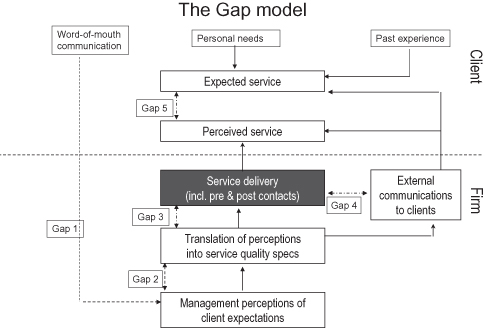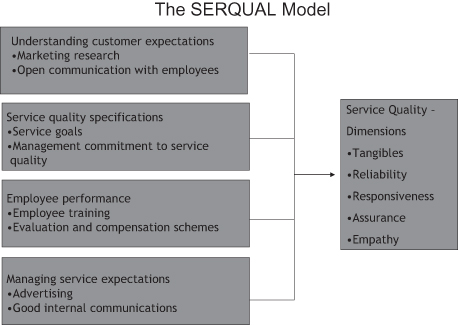![]() GAP MODEL
GAP MODEL
Application: Diagnosis of Client Service Issues, Development of Service Strategy
The Concept
This model (see Figure G.1) is a method of diagnosing difficulties with service quality and analysing the source of potential improvements. It was designed and proposed by a group of academics (Parasuraman et al., 1985) who specialize in service marketing studies. It is built on the assumptions that:
- Quality and customer satisfaction is a comparison between the delivery that customers expect to receive and performance they perceive they receive. Satisfaction depends on the degree to which the two match (or not).
- Customers find service quality more difficult to evaluate than product quality because they have few tangible clues so must rely on other evidence of the quality they are likely to receive.
- Quality evaluation by buyers depends on outcomes and processes. Quality can be influenced by technical outcomes and functional or service outcomes. It can also be influenced by physical aspects of the service and by company image as much as by the interaction with service staff.
Figure G.1: The Gap model

The original investigation to substantiate the model was conducted in financial and product repair services. It has, however, been widely tested and developed since. It identifies and focuses upon five “gaps”:
(i) The management perception gap
This is any difference between management’s views and those of the customers or the market in general.
(ii) The quality specification gap
This exists when quality standards, strategy, or plans do not reflect management objectives or views.
(iii) The service delivery gap
This exists if there is a difference between quality strategy or plans and the firm’s delivery to customers.
(iv) The market communications gap
This tracks any difference between marketing communications (say a lag in customer perception) and service delivery.
(v) The perceived service gap
This exists if there is a difference between the service delivery perceived to be experienced by customers and their expectations. Note the emphasis on perception of experience. What they think they experience may not be reality and might be addressed through marketing campaigns.
Research, customer feedback, and accurate data need to be collected at the point of each gap to compare and contrast opinion or experience. This brings into sharp relief the differences between various perceptions and experiences. It allows the leadership to construct very specific improvement programmes in all relevant areas of business.
History, Context, Criticism, and Development
In the 1980s a group of marketing academics set out to research quality of service in depth. They said that their objectives were to “attack head-on the mystique, mush and myths that surround the service-quality issue” (Ziethaml et al., 1990). They also set out to develop a practical framework by which quality issues could be diagnosed, improved, and managed. After extensive qualitative and large-scale empirical studies they developed the Gap model. Based on that they created an ongoing measurement process called “SERVQUAL” (see Figure G.2).
Figure G.2: The SERVQUAL tracking mechanism

They suggested ten dimensions of quality which should be measured in a systematic way. They are:
- Tangibles: appearance of facilities, personnel equipment etc.
- Reliability: ability to perform the promised service
- Responsiveness: willingness to help
- Competence: possession of the required skills
- Courtesy: politeness, respect etc.
- Credibility: trustworthiness, believability
- Security: freedom from danger or risk
- Access: approachability and ease of contact
- Communication: keeping customers informed
- Understanding: making the effort to know customers and their needs.
Voices and Further Reading
- “The strength of the gap methodology is that it offers generic insights and solutions that can be applied across different industries. What it doesn’t attempt, of course, is to identify specific quality failures that may occur in particular service businesses. Each firm must develop its own customized approach to ensure that service quality becomes and remains a key objective.” Lovelock et al., 1999.
- “The gaps model of service quality brings customer focus and service excellence together in a structured practical way.” Zeithaml and Bitner, 2003.
- Parasuraman, S., Ziethmal, V.A., and Berry, L.L., “A conceptual model of service quality and its implications for future research”. Journal of Marketing, 49, Fall 1985.
- Zeithaml, V.A., Parasuraman, A., and Berry, L.L., Delivering Quality Service. Free Press, 1990.
- “Overnight service-quality miracles are more a figment of lecture-circuit rhetoric than organizational reality. The truth is that it usually takes longer to materially improve service than the sponsors of this change anticipate, and then, it takes longer still for the customers to notice … we lay no claims to breakthrough thinking that will quickly raise an organization’s SERVQUAL scores. Instead we discuss some practical necessities for giving an organization a decent chance to move forward on quality.” Ziethaml et al., ibid.
- “There have been numerous criticisms of SERVQUAL for the inductive nature of the original research in that it failed to draw on the theory base in the disciplines of psychology, social sciences and economics.” Palmer, 2005.
Things You Might Like to Consider
(i) This work demonstrated very effectively that customers’ perception of quality of service depended on the service they perceived they received compared to their articulated and unarticulated expectations.
(ii) This model was based on extensive exploratory research undertaken by several respected researchers and academics. It has general principles which are likely to be applicable across many situations.
(iii) The original phases of the research were completed in the late 1980s and early 1990s in the United States of America. The geographic limitations and the historical context may mean that it needs to be adapted in certain situations.
(iv) Later concepts around “the customer journey” and “customer experience management” have introduced subtleties into service quality thinking which are very relevant to marketers (the expectations raised by the brand for instance and the importance of emotional empathy). This is, nonetheless, a very practical and grounded planning tool.
(v) This is probably, like other tools of the time, a little too linear and fails to really take into account behavioural issues.
![]() RATING: Practical and powerful
RATING: Practical and powerful
